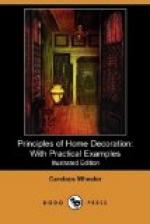To sum up the gospel of furnishing, we need only fall back upon the principles of absolute fitness, actual goodness, and real beauty. If the furniture of a well-coloured room possesses these three qualities, the room as a whole can hardly fail to be lastingly satisfactory. It must be remembered, however, that it is a trinity of virtues. No piece of furniture should be chosen because it is intrinsically good or genuinely beautiful, if it has not also its use—and this rule applies to all rooms, with the one exception of the drawing-room.
The necessity of use, governing the style of furnishing in a room, is very well understood. Thus, while both drawing-room and dining-room must express hospitality, it is of a different kind or degree. That of the drawing-room is ceremonious and punctilious, and represents the family in its relation to society, while the dining-room is far more intimate, and belongs to the family in its relation to friends. In fact, as the dining-room is the heart of the house, its furnishing would naturally be quite different in feeling and character from the drawing-room, although it might be fully as lavish in cost. It would be stronger, less conservative, and altogether more personal in its expression. Family portraits and family silver give the personal note which we like to recognise in our friends’ dining-rooms, because the intimacy of the room makes even family history in place.
In moderate houses, even the drawing-room is too much a family room to allow it to be entirely emancipated from the law of use, but in houses which are not circumscribed in space, and where one or more rooms are set apart to social rather than domestic life, it is natural and proper to gather in them things which stand, primarily, for art and beauty—which satisfy the needs of the mind as distinct from those of bodily comfort. Things which belong in the category of “unrelated beauty” may be appropriately gathered in such a room, because the use of it is to please the eye and excite the interest of our social world; therefore a table which is a marvel of art, but not of convenience, or a casket which is beautiful to look at, but of no practical use, are in accordance with the idea of the room. They help compose a picture, not only for the eyes of friends and acquaintances, but for the education of the family.
It follows that an artistic and luxurious drawing-room may be a true family expression; it may speak of travel and interest in the artistic development of mankind; but even where the experiences of the family have been wide and liberal, if the house and circumstances are narrow, a luxurious interior is by no means a happiness.




